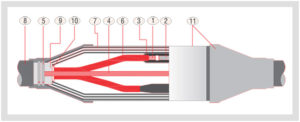
Cable accessories play an important role in maintaining vital insulation at the cable connection points as well as at cable terminations. It is very essential that these cable accessories are safe and easy to handle while being used for installation over a wide array of varied cable cross-sections and it is preferable that they comprise as little components as feasible.
As the trend of using polymeric cables over MV paper insulated cables began many years ago, there has been a steady development of different kinds of cable accessories in use. Earlier it was the heat shrink technology using polyolefin material that was employed for cable terminations as well as for cable joints while now this is being slowly switched to cold shrink and slip-on technology which uses EPDM or silicone. Heat shrink boot used to form a vital cable accessory for offering strain relief on cable terminations, insulate branch joint in addition to harnessing assemblies.
The shift has however, made it a little confusing in ascertaining the most suitable type of cable accessories to be used for electrical settings. The different varieties of cable accessories that are in use today lead one to wonder which provides superior installation technology or superior material or the perfect design for every application. However, it all depends upon the needs of the application and the service conditions.
Some of the main applications of MV cable accessories include outdoor termination, indoor termination, straight joint, separable connector, transition joint etc. Where ever possible the accessory variants can be decreased by employing a single type for varied voltage classes or varied cross-sections or sometimes even varied applications. The two main materials that are increasingly used by manufacturers of MV cable accessories today are EPDM and silicone and the preferred choice depends upon the type of cable accessory application. For outdoor terminations in the cold shrink or slip-on technology, silicone is the preferred choice because of its unique features. For MV cable joints both silicone and EPDM work well in cold shrink and slip-on technologies. A more critical factor than the material in this case is the price aspect. The price factor will determine the choice of material. But if you take the EHV and HV joints the situation changes and silicone with a highly better interface behavior becomes the favorite.
As far as the separable connectors are concerned the material requirements are different. Specific silicone products that have a metallic enclosure are suited for the exterior cone system. On a large scale, however, the exterior cone types are made of EPDM. This is because besides the price factor certain extra needs have to be met like the full screening of the separable connector as well as fulfillment of the touchability factor to ensure the personnel’s total safety. So, if the exterior semi-conductive layer is comprised of EPDM then it enhances the reliability and cost-effectiveness as against the silicone layer.
Summarizing, it can be stated that the preferred choice of material in today’s times for the MV cable accessories will ultimately depend upon the application of the cable accessories.